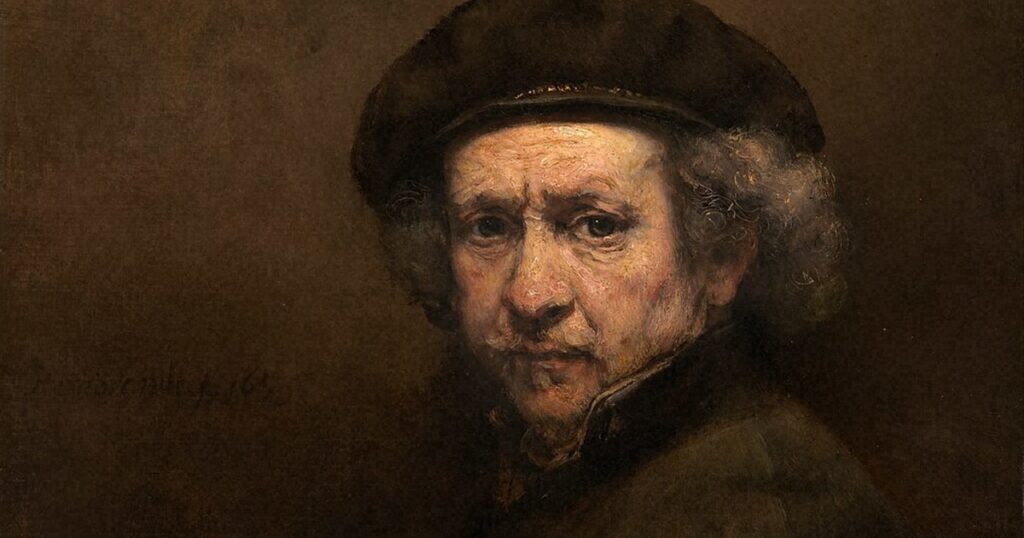By Damian Flanagan
I recently spent a few days in the Netherlands with my two daughters, and when stopped at Immigration and asked the purpose of my visit I was able to respond, with not great inaccuracy: “Rembrandt, I guess.”
I’ve been on the Rembrandt trail for a few decades and occasionally like to pop in and admire “The Night Watch” or gaze at the works of the other Dutch masters like Vermeer and Franz Hals at the Rijksmuseum in Amsterdam. It was a pleasure to introduce these old friends to my 12- and 14-year-old daughters, and as part of our mini tour of Dutch art, we also took a stroll round the Rembrandt House Museum there, somewhere that I had not visited in over 30 years.
The vague outline of Rembrandt’s life — that he had enjoyed great fame and success in his younger years before going out of vogue and suffering a crushing bankruptcy in his fifties — was familiar to me. But only when you visit the handsome Rembrandt House do you fully appreciate all the peculiar quirks of Rembrandt’s life. There is the tiny box bed, located in the ground floor sitting room, where Rembrandt slept with his first wife Saskia — and then after her death with his partner Hendrickje — a bed so small that in accordance with the custom of the time the occupants did not lie flat but slept in a crouched position. You are reminded of the agonizing series of familial losses that Rembrandt endured, with first one daughter and then another — both named Cornelia — dying not long after birth before a third daughter, still tenaciously called Cornelia, finally survived past infancy. Rembrandt also suffered the deaths of his beloved first wife Saskia, then his partner Hendrickje, and finally his son Titus.
Rembrandt lived in a bustling, cosmopolitan area of Amsterdam where the curators are keen to tell us was “diverse,” with both black and Jewish communities. Rembrandt had a front room on the ground floor of the house where he discussed commissions and on the top floor, he had an atelier where he taught students, providing him with a useful income. It was fascinating to learn about the materials Rembrandt used to produce paint pigment — including dyes derived from berries, beetles and ground cobalt — and the techniques involved in his profuse production of etchings.
But the room that most caught my eye in the house was the one containing a reproduction of Rembrandt’s personal collection of curiosities. Like many wealthy and successful people of the age, Rembrandt was a collector of unusual and beautiful items from all over the world, including antique busts, coral and seashells; swords, shields and spears; and the hides of exotic animals.
Rembrandt himself never left the Netherlands. Yet it’s easy to forget that the Netherlands in the Dutch Golden Age of the 17th century stood at the centre of a vast international empire that encompassed holdings in the Caribbean, South America, South Africa, Ceylon (Sri Lanka) and modern-day Indonesia. Like New York in the 20th century and London in the 19th, the Amsterdam of the 17th Century was a place where riches, influences and information from all over the world were pouring into the thriving metropolis. It must have felt like you didn’t need to actively go out and explore the world, the entire world was funnelling its cultural riches towards you. Rembrandt was even able to produce 23 drawings of Mughal India without ever leaving his native land.
Amidst the curious items in Rembrandt’s prized collection is one particularly surprising object: a Japanese samurai helmet. At the furthest extent of the Netherlands’ vast trading networks, at the time of Rembrandt’s artistic prime in the 1640s and 1650s, the Netherlands enjoyed exclusive European access to Japan due to its trading base in Dejima, an island near Nagasaki.
It’s well known how influential Japanese art was on Dutch masters like Van Gogh in the late nineteenth century, but it’s rather startling to see a samurai helmet in Rembrandt’s possession in the 1650s. Was this just another curiosity amongst many?
I don’t think it was. And to understand the significance of this item to Rembrandt you have to consider just how obsessed he was about headwear. This is not surprising given that so many of Rembrandt’s paintings are head-and-shoulders portraits where the headwear stands out in counterpoise to the face below. An exotic feather or the velvet folds of a hat or the glint of metal on a helmet often defines the whole composition.
When Rembrandt painted himself as an artist, he usually wears upon his head a beret or some other defining headwear. In fact, the long-running tradition of the beret-wearing painter derives directly from Rembrandt, who believed that if you are to play a role in life then you should look the part, and you start by getting your headwear right. When Rembrandt set to work in his studio on a canvas, we can imagine him flamboyantly donning his beret like a footballer pulling on a shirt to go out and play.
When Rembrandt imagined what it was like to be part of other cultures, he also started with the headgear. Rembrandt displayed an orientalist fascination with Turkish and Persian dress, something he painted repeatedly, but it was the turban in particular that beguiled him. We know from the comments of one of his students that Rembrandt could spend a full two days arranging a turban to get it exactly right before embarking on a picture.
For someone with such a deep fascination with exotic eastern cultures, who believed that donning a head dress defines your identity, then a Japanese helmet is not simply any other object but rather a portal into an imaginative consideration of what it meant to be Japanese.
Rembrandt’s prints were actually produced on Japanese paper and the Dutch head of the Japanese mission near Nagasaki collected Rembrandt’s works, so a consciousness of Japan was much closer to Rembrandt than we might anticipate. The Japanese helmet does indeed feature in one of Rembrandt’s sketches.
Rembrandt’s original belongings were sold off at auction following his insolvency in 1656, but an inventory of the sale remains and informs us of the exact contents of the house. In 2022, a similar style of samurai helmet (known as zunari kabuto) was returned to the house to reflect the one that had once been on display. The long-lost “Japanese” side of Rembrandt had finally been restored.
Like most great artists, Rembrandt had an endlessly inquisitive and empathetic mind that was always looking to mentally explore and interact with the furthest reaches of the world, a mind that saw the potential of donning a Japanese helmet and imaginatively transporting himself to the most distant Dutch outpost in the world.
(This is Part 51 of a series)
In this column, Damian Flanagan, a researcher in Japanese literature, ponders about Japanese culture as he travels back and forth between Japan and Britain.
Profile:
Damian Flanagan is an author and critic born in Britain in 1969. He studied in Tokyo and Kyoto between 1989 and 1990 while a student at Cambridge University. He was engaged in research activities at Kobe University from 1993 through 1999. After taking the master’s and doctoral courses in Japanese literature, he earned a Ph.D. in 2000. He is now based in both Nishinomiya, Hyogo Prefecture, and Manchester. He is the author of “Natsume Soseki: Superstar of World Literature” (Sekai Bungaku no superstar Natsume Soseki).
Premium IPTV Experience with line4k
Experience the ultimate entertainment with our premium IPTV service. Watch your favorite channels, movies, and sports events in stunning 4K quality. Enjoy seamless streaming with zero buffering and access to over 10,000+ channels worldwide.

















